Wednesday 11 August 2010
Hiatus
Just an announcement this time: there won't be any updates here for a while now (probably for about three weeks at least). I'm going to Finland this Saturday and will stay there for two weeks. I'm really excited, it'll be so good to see my family and friends again! I do have some postcards that I know I'm going to post about when I get back, but yeah, that's going to have to wait.
Sunday 8 August 2010
Moldova
Overall, I don't get a huge variety of different countries with the postcards I receive, so I thought I'd take this opportunity to post about cards from different countries here whenever possible. The following card is definitely one from a country I don't received cards from too often.
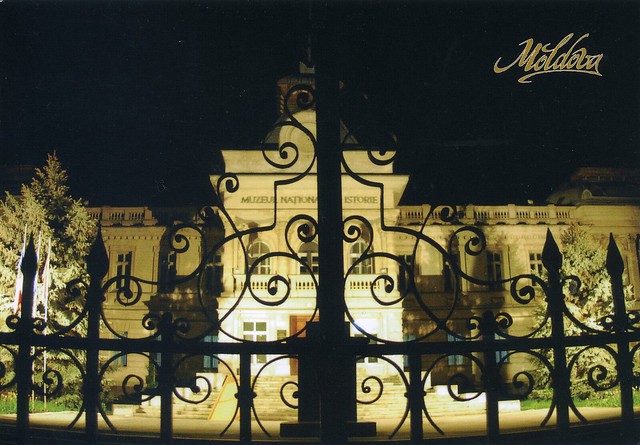
MD-2037
The card shows the National History Museum of Moldova, a museum in Chişinău, the capital city of Moldova. Over 263,000 exhibits, 165000 of which belong to the national heritage, are exhibited in the National Museum of History, founded in 1983 on the former Regional Lyceum. It is situated on 121a, 31 August 1989 str., in the historical center of Chişinău.

The stamp is very pretty, but unfortunately I couldn't find any info regarding it. It would seem to be related to the National Museum of Ethnography and Natural History, the oldest museum in Moldova, though.

The card shows the National History Museum of Moldova, a museum in Chişinău, the capital city of Moldova. Over 263,000 exhibits, 165000 of which belong to the national heritage, are exhibited in the National Museum of History, founded in 1983 on the former Regional Lyceum. It is situated on 121a, 31 August 1989 str., in the historical center of Chişinău.

The stamp is very pretty, but unfortunately I couldn't find any info regarding it. It would seem to be related to the National Museum of Ethnography and Natural History, the oldest museum in Moldova, though.
Lankaran, Azerbaijan
I don't seem to have much logic with my posting today.. :P Well, apart from the fact that I post about cards I really like, haha. I've actually been meaning to post about this specific card pretty much since I started this blog, but for some reason haven't got round to it until now.
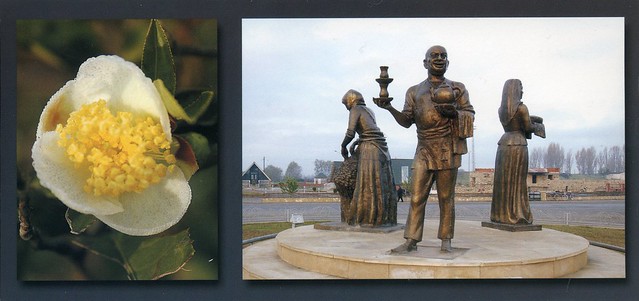
And why is this card so special, you ask. Well, because it's tea-related! :) This card shows a sculptural group at the entrance to Lankaran city, devoted to TEA! How awesome is that?! Those who know me a bit better, know that I'm a tea addict and rather obsessed with the stuff. Therefore, postcards related to tea are always more than welcome in my collection. Mmmm, and the picture on the left shows a tea shrub, they open their flowers with delicate aroma in December (that's what the card says, anyway).
A bit more about Lankaran... The city is located on the coast of the Caspian Sea, near the southern border with Iran and has a population of 50,244.
Dominating spheres in Lankaran economy are vegetable-growing, tea-growing, paddy cultivating, cattle-breeding, citrus plants, beekeeping, fishing, and grain farming. Favourable humid subtropical climate, availability of good arable land, water and sufficient labour resources of city provides a good basis for agricultural activities as well as development of agro-processing enterprises. The city is also home of Azerbaijan's first tea plant, built in 1937. Tea-cultivation and processing industry became important in the area during the 20th century.
There seem to be several tea-related sculptures in Lankaran; this HUGE samovar is pretty cool as well!

The card came in an envelope as the sender, Yana, told me that Azerbaijan post isn't very reliable. I'd have to agree as I never received her first postcard :( ...I've always wondered, where does all this lost mail end up to? Do postmen just steal it, or is there a different explanation?
Anyway, as for the stamp, it is a definitive stamp issued in 2006, showing Heydar Aliyev, the third President of Azerbaijan for the New Azerbaijan Party from June 1993 to October 2003

And why is this card so special, you ask. Well, because it's tea-related! :) This card shows a sculptural group at the entrance to Lankaran city, devoted to TEA! How awesome is that?! Those who know me a bit better, know that I'm a tea addict and rather obsessed with the stuff. Therefore, postcards related to tea are always more than welcome in my collection. Mmmm, and the picture on the left shows a tea shrub, they open their flowers with delicate aroma in December (that's what the card says, anyway).
A bit more about Lankaran... The city is located on the coast of the Caspian Sea, near the southern border with Iran and has a population of 50,244.
Dominating spheres in Lankaran economy are vegetable-growing, tea-growing, paddy cultivating, cattle-breeding, citrus plants, beekeeping, fishing, and grain farming. Favourable humid subtropical climate, availability of good arable land, water and sufficient labour resources of city provides a good basis for agricultural activities as well as development of agro-processing enterprises. The city is also home of Azerbaijan's first tea plant, built in 1937. Tea-cultivation and processing industry became important in the area during the 20th century.
There seem to be several tea-related sculptures in Lankaran; this HUGE samovar is pretty cool as well!

The card came in an envelope as the sender, Yana, told me that Azerbaijan post isn't very reliable. I'd have to agree as I never received her first postcard :( ...I've always wondered, where does all this lost mail end up to? Do postmen just steal it, or is there a different explanation?
Anyway, as for the stamp, it is a definitive stamp issued in 2006, showing Heydar Aliyev, the third President of Azerbaijan for the New Azerbaijan Party from June 1993 to October 2003
Iceland
Moving on... to somewhere VERY different from Dubai: Iceland! This country has always fascinated me. It seems so distant, rough, beautiful and mysterious. I received this card earlier this year, I think it's still my only written and stamped postcard from Iceland, which makes it even more special.
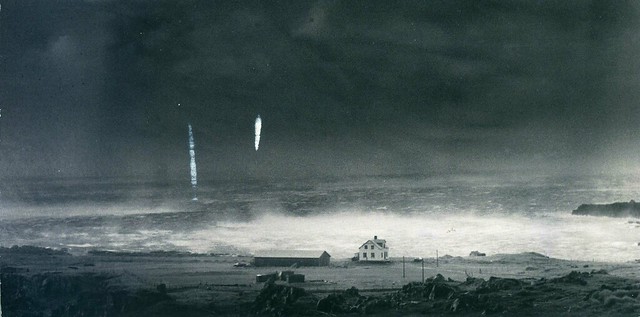
IS-8497
Now I wouldn't want to live in such a remote, rough location, but I do have to admit this picture totally fascinates me. Just trying to imagine the kind of people who would live in this place... it can't be too easy! It must have its beauty to it, though, it seems so extreme and out of this world.
One thing that has always struck me with Island is how small it is. I mean the whole country has a population of only about 320,000, that's like an average size UK city! Icelandic people sure seem a lot more hard working than a lot of English people :p
I've been wondering why Finland is the only Nordic country (out of Finland, Sweden, Norway, Denmark and Iceland) with a large number of postcrossers. Ok, with Iceland it is pretty understandable as the country is so small, but Sweden is bigger than Finland.. I've heard postage there is stupidly expensive, though, so maybe that's one reason.. and Norway is a really expensive country as well. I don't know about Denmark... It's a shame, I'd like to see more postcards from these countries, especially Norway and Iceland.

Icelandic stamps are really pretty, from what I've seen, and this is no exception. It's from an issue of 2 stamps from 2009, depicting Skaftafell, Vatnajokull National Park.

Now I wouldn't want to live in such a remote, rough location, but I do have to admit this picture totally fascinates me. Just trying to imagine the kind of people who would live in this place... it can't be too easy! It must have its beauty to it, though, it seems so extreme and out of this world.
One thing that has always struck me with Island is how small it is. I mean the whole country has a population of only about 320,000, that's like an average size UK city! Icelandic people sure seem a lot more hard working than a lot of English people :p
I've been wondering why Finland is the only Nordic country (out of Finland, Sweden, Norway, Denmark and Iceland) with a large number of postcrossers. Ok, with Iceland it is pretty understandable as the country is so small, but Sweden is bigger than Finland.. I've heard postage there is stupidly expensive, though, so maybe that's one reason.. and Norway is a really expensive country as well. I don't know about Denmark... It's a shame, I'd like to see more postcards from these countries, especially Norway and Iceland.

Icelandic stamps are really pretty, from what I've seen, and this is no exception. It's from an issue of 2 stamps from 2009, depicting Skaftafell, Vatnajokull National Park.
Dubai Museum
More old cards... This is actually one of my oldest postcrossing swap cards - it's from December 2007! I like it how it's also a slightly different postcard of Dubai in that it doesn't show one of the most famous landmarks (Burj Al Arab?).
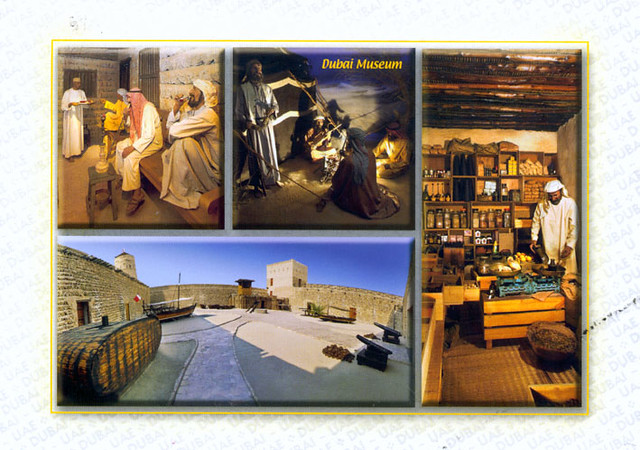
Dubai Museum is the main museum in Dubai, United Arab Emirates. It is located in the Al Fahidi Fort, built in 1787 and is the oldest existing building in Dubai. The museum was opened by the ruler of Dubai in 1971, with the aim of presenting the traditional way of life in the Emirate of Dubai. The museum houses many exhibits from Dubai's history. There are several static displays showing Dubai life from ages past, including souk, fishing, domestic and desert travel scenes.
Galleries show scenes from the Creek, traditional Arab houses, mosques, the souk, date farms as well as desert and marine life. These galleries reflect the nature of the UAE, from the beach to the city and the oasis areas to the nomadic Bedouin culture.
Artifacts from several excavated sites in Dubai date back to the third millennium B.C. The two main excavated sites in Dubai were discovered in Jumeirah and Al Qusais.


The stamps are from a set of 7 definitives from 2007, called the 5th Definitive Series. The design shows the word "Emirates" in Arabic, shaped as a falcon.

Dubai Museum is the main museum in Dubai, United Arab Emirates. It is located in the Al Fahidi Fort, built in 1787 and is the oldest existing building in Dubai. The museum was opened by the ruler of Dubai in 1971, with the aim of presenting the traditional way of life in the Emirate of Dubai. The museum houses many exhibits from Dubai's history. There are several static displays showing Dubai life from ages past, including souk, fishing, domestic and desert travel scenes.
Galleries show scenes from the Creek, traditional Arab houses, mosques, the souk, date farms as well as desert and marine life. These galleries reflect the nature of the UAE, from the beach to the city and the oasis areas to the nomadic Bedouin culture.
Artifacts from several excavated sites in Dubai date back to the third millennium B.C. The two main excavated sites in Dubai were discovered in Jumeirah and Al Qusais.


The stamps are from a set of 7 definitives from 2007, called the 5th Definitive Series. The design shows the word "Emirates" in Arabic, shaped as a falcon.
Mount Sannine, Lebanon
One more card from the Mediterranean countries... although this picture obviously isn't by the seaside :P
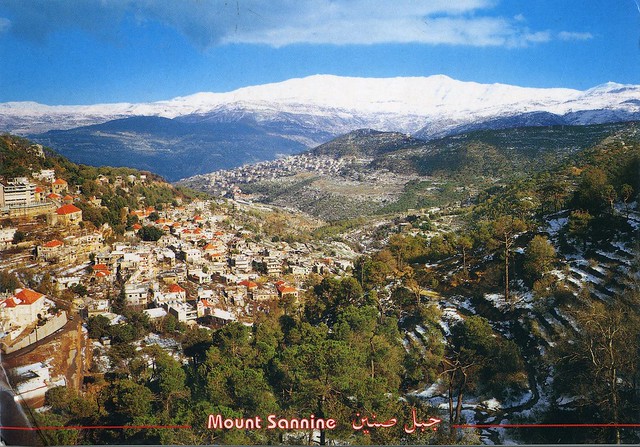
Mount Sannine is a mountain in the Mount Lebanon range. Its highest point is 2,628 m above sea level. It's located northeast of Beirut, Lebanon's capital city. I couldn't find any more info about the area but it does look like a gorgeous place. Amazing sceneries!

The stamp is from a set of 2 stamps issued in 2007, commemorating the 50th Anniversary of the Baalbeck International Festival.

Mount Sannine is a mountain in the Mount Lebanon range. Its highest point is 2,628 m above sea level. It's located northeast of Beirut, Lebanon's capital city. I couldn't find any more info about the area but it does look like a gorgeous place. Amazing sceneries!

The stamp is from a set of 2 stamps issued in 2007, commemorating the 50th Anniversary of the Baalbeck International Festival.
Saturday 7 August 2010
Sousse, Tunisia
Staying by the Mediterranean (and old cards)... This one is actually a German official card, but sent from Tunisia during the sender's holiday there. I know there are people who don't really like it when the postcard code and the country on the card don't match, but I don't mind, especially when the card has been sent from holidays. I think it's a brilliant idea, especially as it seems like people don't send so many cards from their holidays anymore.

DE-376397
Sousse is located 140 km south of the capital Tunis, in the central-east of the country, on the Gulf of Hammamet, which is a part of the Mediterranean Sea. Its economy is based on transport equipment, processed food, olive oil, textiles and tourism.
Sousse is considered one of the best examples of seaward-facing fortifications built by the Arabs. Its ribat, a soaring structure that combined the purposes of a minaret and a watch tower, is in outstanding condition and draws visitors from around the world.
These days, Sousse, with a population of more than 540,000, retains a medieval heart of narrow, twisted streets, a kasbah and medina, its ribat fortress and long wall on the Mediterranean. Surrounding it is a modern city of long, straight roads and more widely spaced buildings. The medina is also a Unesco World Heritage Site.
I'm not 100 % sure, but it looks like the author of this amazing blog lives in Sousse, or at least it looks an awful lot like Sousse. (The last couple of weeks she's been on holiday in Finland, but the majority of photos there are from Tunisia, and they are AMAZING. That blog is amongst my favourites.) It's really made me want to visit this beautiful country, if only I had more money to travel... *sigh*

The stamp is very pretty. It's from a set of 4 stamps issued in 2008 regarding Terracotta Objects, this one here being terracotta dish Kairouan.

Sousse is located 140 km south of the capital Tunis, in the central-east of the country, on the Gulf of Hammamet, which is a part of the Mediterranean Sea. Its economy is based on transport equipment, processed food, olive oil, textiles and tourism.
Sousse is considered one of the best examples of seaward-facing fortifications built by the Arabs. Its ribat, a soaring structure that combined the purposes of a minaret and a watch tower, is in outstanding condition and draws visitors from around the world.
These days, Sousse, with a population of more than 540,000, retains a medieval heart of narrow, twisted streets, a kasbah and medina, its ribat fortress and long wall on the Mediterranean. Surrounding it is a modern city of long, straight roads and more widely spaced buildings. The medina is also a Unesco World Heritage Site.
I'm not 100 % sure, but it looks like the author of this amazing blog lives in Sousse, or at least it looks an awful lot like Sousse. (The last couple of weeks she's been on holiday in Finland, but the majority of photos there are from Tunisia, and they are AMAZING. That blog is amongst my favourites.) It's really made me want to visit this beautiful country, if only I had more money to travel... *sigh*

The stamp is very pretty. It's from a set of 4 stamps issued in 2008 regarding Terracotta Objects, this one here being terracotta dish Kairouan.
Valletta, Malta
Another old card, this one is an official from last summer.

MT-1249
Valletta is the capital city of Malta. It is located in the central-eastern portion of the island of Malta and the city proper has a population of 6,098. According to Eurostat, urban zone of Valletta has a population of 368,250.
Valletta contains buildings from the 16th century onwards, built during the rule of the Knights of St. John of Jerusalem (the Knights Hospitaller). The city is essentially Baroque in character, with elements of Mannerist, Neo-Classical and Modern architecture in selected areas, though World War II left major scars on the city. The City of Valletta was officially recognised as a World Heritage Site by UNESCO in 1980.

The stamp is from a set of 2 stamps issued in 2008. They're from the Europa series, this year's theme being "Letters".

Valletta is the capital city of Malta. It is located in the central-eastern portion of the island of Malta and the city proper has a population of 6,098. According to Eurostat, urban zone of Valletta has a population of 368,250.
Valletta contains buildings from the 16th century onwards, built during the rule of the Knights of St. John of Jerusalem (the Knights Hospitaller). The city is essentially Baroque in character, with elements of Mannerist, Neo-Classical and Modern architecture in selected areas, though World War II left major scars on the city. The City of Valletta was officially recognised as a World Heritage Site by UNESCO in 1980.

The stamp is from a set of 2 stamps issued in 2008. They're from the Europa series, this year's theme being "Letters".
Cyprus
I thought I'd post some older cards for a change. I have so many that I really want to post about, I just never seem to have the time. ...and I'll have a two weeks break soon as I'll be off to Finland in a week.
Anyway, starting off with this lovely card from Cyprus.

This is one of the weirdest cards I've ever received through Postcrossing. Not so much because of the picture or anything like that, but because of the way I got it. I got a message from a Finnish woman living in Cyprus asking me if I'd like some postcards from Cyprus. Apparently she likes sending cards to random people and doesn't want anything in return for this. (I would've liked to send her something back as she sent me some truly gorgeous cards but I never got her address :(). You don't come across people like that too often!
This card shows a local pub in some village in Cyprus. The sender tells me that only men ever go there, although some female tourists occasionally turn up if they are thirsty.

The bigger stamp is from a set of 8 stamps issued in 2008, depicting Cyprus through the Ages. This one here is a Female Figurine. The other stamp is a 2008 reprint of the Refugee Fund tax stamp.
Anyway, starting off with this lovely card from Cyprus.

This is one of the weirdest cards I've ever received through Postcrossing. Not so much because of the picture or anything like that, but because of the way I got it. I got a message from a Finnish woman living in Cyprus asking me if I'd like some postcards from Cyprus. Apparently she likes sending cards to random people and doesn't want anything in return for this. (I would've liked to send her something back as she sent me some truly gorgeous cards but I never got her address :(). You don't come across people like that too often!
This card shows a local pub in some village in Cyprus. The sender tells me that only men ever go there, although some female tourists occasionally turn up if they are thirsty.

The bigger stamp is from a set of 8 stamps issued in 2008, depicting Cyprus through the Ages. This one here is a Female Figurine. The other stamp is a 2008 reprint of the Refugee Fund tax stamp.
Inge Löök grannies
I love Inge Löök's grannies, they are so anarchistic and really seem to enjoy life. They are just so much fun! :)
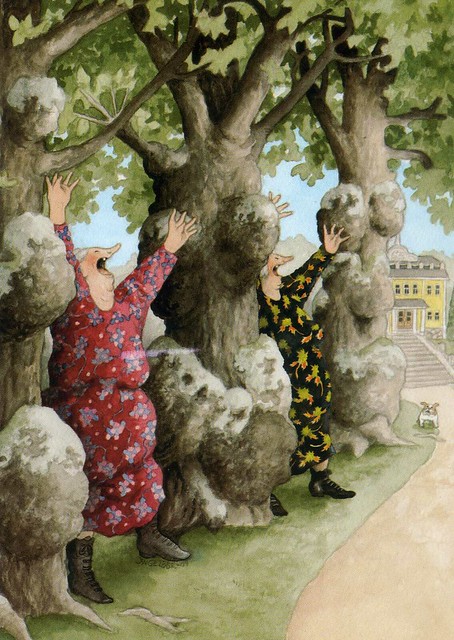
This is such a cool card - sent by the lovely Lilla in Finland, it's from the "Cards with thematic stamps" RR which I really like and hope to join some more groups after coming back home from Finland in a few weeks. Both the card and the stamp are women-related here. The stamp is even more amazing than the card... look:

It's from Åland!! The stamp is from a set of 3 stamps issued in 2009 showing Åland Authors, this one here is Anni Blomqvist. She is known, amongst other things, for the Stormskärs-Maja series ("Myrskyluodon Maija" in Finnish; "Maija from the Storm Skerries"). I'm not sure if I've ever read any of the books in this series, but I'm pretty sure I've watched some of the tv show from the 70s with the same title, and I really love the theme song for this series. It was composed by Lasse Mårtenson, a Finnish singer, composer and actor, and it's SO beautiful. I was really pleased to find it in Youtube, and have included it below. Do check it out!

This is such a cool card - sent by the lovely Lilla in Finland, it's from the "Cards with thematic stamps" RR which I really like and hope to join some more groups after coming back home from Finland in a few weeks. Both the card and the stamp are women-related here. The stamp is even more amazing than the card... look:

It's from Åland!! The stamp is from a set of 3 stamps issued in 2009 showing Åland Authors, this one here is Anni Blomqvist. She is known, amongst other things, for the Stormskärs-Maja series ("Myrskyluodon Maija" in Finnish; "Maija from the Storm Skerries"). I'm not sure if I've ever read any of the books in this series, but I'm pretty sure I've watched some of the tv show from the 70s with the same title, and I really love the theme song for this series. It was composed by Lasse Mårtenson, a Finnish singer, composer and actor, and it's SO beautiful. I was really pleased to find it in Youtube, and have included it below. Do check it out!
Rhodes, Greece
Funny - I just mentioned Rhodes a few posts ago and now I received a postcard of it! It's not mailed directly from Rhodes but it's still pretty cool. (AND it's an official from a girl I did a direct swap with not long ago! :D) I have such great memories from my holiday in Rhodes when I was a kid. Eating tons of ice cream, going to beaches, enjoying the sun... They must get lots of tourists from Finland, or at least used to get, because I remember in quite a few places there people could speak some Finnish, which I found really weird.

GR-12933
This card shows the Palace of the Grand Master of the Knights of Rhodes, a palace in the town of Rhodes. The palace was built in the 14th century by the Knights of Rhodes, who occupied Rhodes from 1309 to 1522. After the island was captured by the Ottoman Empire, the palace was used as a fortress.
The original palace was largely destroyed by an ammunition explosion in 1856. When the Kingdom of Italy occupied Rhodes in 1912, the Italians rebuilt the palace in a grandiose pseudo-medieval style as a holiday residence for Victor Emmanuel III of Italy, and later for Benito Mussolini, whose name can still be seen on a large plaque near the entrance.
On 10 February 1947, the Treaty of Peace with Italy, one of the Paris Peace Treaties, determined than the recently-established Italian Republic would transfer the Dodecanese to the Kingdom of Greece. In 1948, Rhodes and the rest of the Dodecanese were transferred as previously agreed. The Greeks converted the palace to a museum.

This card shows the Palace of the Grand Master of the Knights of Rhodes, a palace in the town of Rhodes. The palace was built in the 14th century by the Knights of Rhodes, who occupied Rhodes from 1309 to 1522. After the island was captured by the Ottoman Empire, the palace was used as a fortress.
The original palace was largely destroyed by an ammunition explosion in 1856. When the Kingdom of Italy occupied Rhodes in 1912, the Italians rebuilt the palace in a grandiose pseudo-medieval style as a holiday residence for Victor Emmanuel III of Italy, and later for Benito Mussolini, whose name can still be seen on a large plaque near the entrance.
On 10 February 1947, the Treaty of Peace with Italy, one of the Paris Peace Treaties, determined than the recently-established Italian Republic would transfer the Dodecanese to the Kingdom of Greece. In 1948, Rhodes and the rest of the Dodecanese were transferred as previously agreed. The Greeks converted the palace to a museum.
Friday 6 August 2010
Jiufen, Taipei, Taiwan
I'll finish off today with Taiwan.. This lovely card arrived from a swap with Moonie in Taiwan. She actually visited Indonesia recently and I asked if she could send me a postcard from there instead (as I don't have many cards from Indonesia) but she didn't have chance to pick a postcard from there so sent me this instead. I have to say I'm more than happy with this one, too, there are some truly amazing sceneries in Taiwan!

This is a view from Jiufen, a mountain town in the Rueifang Township of Taipei County near Keelung, Taiwan. Jiufen was only an isolated village until 1893, when gold was discovered in the area. The resulting gold rush hastened the village's development into a town, and reached its peak during the Japanese rule. Many present features of Jiufen reflect the era under Japanese colonization, with many Japanese inns surviving to this day. During World War II, a POW camp named Kinkaseki was set up in the village, holding Allied soldiers captured in Singapore (including many British) who worked in the nearby gold mines. Gold mining activities declined after World War II, and the mine was shut off in 1971. Jiufen quickly went into decline, and for a while the town was mostly forgotten.
In 1989, Hou Hsiao-hsien's A City of Sadness, the first film to touch on the 228 Incident, a taboo subject in Taiwan, became a big hit in the theatres. As a result Jiufen, where the film was set, revived due to the film's popularity. The nostalgic scenery of Jiufen as seen in the film, as well as appearances in other media, charmed many people into visiting Jioufen. For the beginning of the 90s, Jiufen experienced a tourist boom that has shaped the town as a tourist attraction. Soon retro-Chinese style cafés, tea houses, and souvenir stores bearing the name "City of Sadness" were built.
Jiufen also became popular in 2001, when its downtown was used as a model in the anime movie Spirited Away.
I'm pretty sure I have postcards of Jiufen already - I googled it and the narrow lanes with red lanterns look familiar. It's nice to see the place from a different angle for a change. :)

The stamp on the left would seem to be from a set of 11 definitive stamps issued in 2005, showing fruit. I'm not sure what this one here is called, it looks like some citrus fruit. I couldn't find any info on the stamp in the middle, and I'd assume the stamp on the right was issued earlier this year as it's the Year of the Tiger at the moment.

This is a view from Jiufen, a mountain town in the Rueifang Township of Taipei County near Keelung, Taiwan. Jiufen was only an isolated village until 1893, when gold was discovered in the area. The resulting gold rush hastened the village's development into a town, and reached its peak during the Japanese rule. Many present features of Jiufen reflect the era under Japanese colonization, with many Japanese inns surviving to this day. During World War II, a POW camp named Kinkaseki was set up in the village, holding Allied soldiers captured in Singapore (including many British) who worked in the nearby gold mines. Gold mining activities declined after World War II, and the mine was shut off in 1971. Jiufen quickly went into decline, and for a while the town was mostly forgotten.
In 1989, Hou Hsiao-hsien's A City of Sadness, the first film to touch on the 228 Incident, a taboo subject in Taiwan, became a big hit in the theatres. As a result Jiufen, where the film was set, revived due to the film's popularity. The nostalgic scenery of Jiufen as seen in the film, as well as appearances in other media, charmed many people into visiting Jioufen. For the beginning of the 90s, Jiufen experienced a tourist boom that has shaped the town as a tourist attraction. Soon retro-Chinese style cafés, tea houses, and souvenir stores bearing the name "City of Sadness" were built.
Jiufen also became popular in 2001, when its downtown was used as a model in the anime movie Spirited Away.
I'm pretty sure I have postcards of Jiufen already - I googled it and the narrow lanes with red lanterns look familiar. It's nice to see the place from a different angle for a change. :)

The stamp on the left would seem to be from a set of 11 definitive stamps issued in 2005, showing fruit. I'm not sure what this one here is called, it looks like some citrus fruit. I couldn't find any info on the stamp in the middle, and I'd assume the stamp on the right was issued earlier this year as it's the Year of the Tiger at the moment.
Li River, China
Another cool card from China; I just love the colours in this one! The atmosphere here looks very calm and peaceful, too, it must be a great place for relaxation.
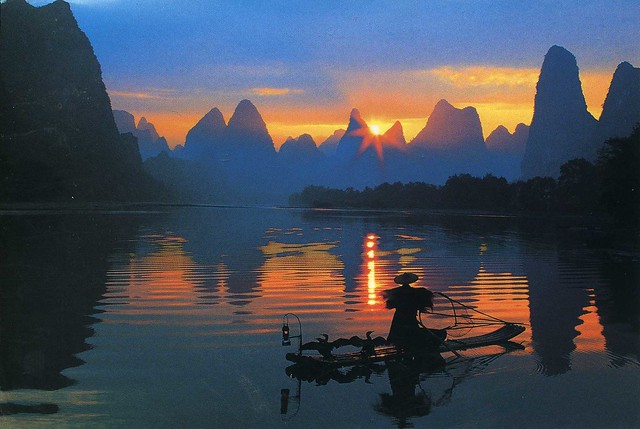
This is a view of Li River in Guangxi Province, China. The River Li originates in the Mao'er Mountains in Xing'an Сounty and flows in the general southern direction through Guilin, Yangshuo and Pingle. In Pingle the Li River merges with two other streams, and continues south as the Gui River, which falls into the Xi Jiang, the western tributary of the Pearl River, in Wuzhou.
The 437-kilometer course of the Li and Gui Rivers is flanked by green hills. Cormorant fishing is often associated with the Lijiang, and you can see an example of it here.

Chinese stamps are so beautiful! It's frustratingly difficult to find any info on them, though, and I couldn't find anything on the three stamps at the top. The small one is from a set of 6 definitives issued in 2002 with the theme "Protecting the common homeland".
I'm really impressed with how quickly this card travelled, too! Usually mail from China takes ages to reach England, but I received this postcard in about a week!

This is a view of Li River in Guangxi Province, China. The River Li originates in the Mao'er Mountains in Xing'an Сounty and flows in the general southern direction through Guilin, Yangshuo and Pingle. In Pingle the Li River merges with two other streams, and continues south as the Gui River, which falls into the Xi Jiang, the western tributary of the Pearl River, in Wuzhou.
The 437-kilometer course of the Li and Gui Rivers is flanked by green hills. Cormorant fishing is often associated with the Lijiang, and you can see an example of it here.

Chinese stamps are so beautiful! It's frustratingly difficult to find any info on them, though, and I couldn't find anything on the three stamps at the top. The small one is from a set of 6 definitives issued in 2002 with the theme "Protecting the common homeland".
I'm really impressed with how quickly this card travelled, too! Usually mail from China takes ages to reach England, but I received this postcard in about a week!
Lijiang, China
I'm really starting to get into postcards showing people and scenes of ordinary life, they can be so much more interesting than cards showing famous sights and landmarks. It's a shame they are not more common.. and also pretty much impossible to find where I live, although then I'm not sure what kind of images you would get in the West Midlands... :P

This very nice card came from China from a tag. It shows a scene from an ancient town called Lijiang in the YunGui plateau, located in southwestern China. Less than 1.5 square kms in area, the ancient town district was first built in the period of Song and Yuan Dynasties, and the remaining houses of the aborigines were mostly built in the Period of Ming and Qing Dynasties.
Lijiang was once a confluence for trade along the old tea horse road. The Lijiang old town is famous for its orderly system of waterways and bridges. The old town of Lijiang differs from other ancient Chinese cities in architecture, history and the culture of its traditional residents the Nakhi people. The town is also a Unesco World Heritage Site.

Unless I'm very much mistaken, the stamp on the right comes from a set of 3 stamps issued in 2003, depicting Double Ninth Festival (The Double Ninth Festival, falling on the ninth day of the ninth month of the lunar calendar, is one of China's traditional festivals.). The theme here is "Playing Chess and Drinking Wine". The other stamp is from a set of 3 definitives issued in 2002, depicting Chinese birds.

This very nice card came from China from a tag. It shows a scene from an ancient town called Lijiang in the YunGui plateau, located in southwestern China. Less than 1.5 square kms in area, the ancient town district was first built in the period of Song and Yuan Dynasties, and the remaining houses of the aborigines were mostly built in the Period of Ming and Qing Dynasties.
Lijiang was once a confluence for trade along the old tea horse road. The Lijiang old town is famous for its orderly system of waterways and bridges. The old town of Lijiang differs from other ancient Chinese cities in architecture, history and the culture of its traditional residents the Nakhi people. The town is also a Unesco World Heritage Site.

Unless I'm very much mistaken, the stamp on the right comes from a set of 3 stamps issued in 2003, depicting Double Ninth Festival (The Double Ninth Festival, falling on the ninth day of the ninth month of the lunar calendar, is one of China's traditional festivals.). The theme here is "Playing Chess and Drinking Wine". The other stamp is from a set of 3 definitives issued in 2002, depicting Chinese birds.
Wednesday 4 August 2010
Egypt
I thought I'd finish today with something a little different. This is such a cool card, from the lovely Farah in Egypt.

Here you can see an Egyptian dancer in belly-dancing costume. Farah tells me the costumes are sold in all shapes, sizes and colours at the famous Khan El Khalili bazaar in the old part of Cairo.

This is such a perfect postcard - it's from a "Cards with thematic stamps" RR and here both the stamps AND the card are women-related. Egyptian stamps look pretty amazing, I really like them! The two stamps at the top are a set of 2 stamps issued in 2008 for the 2nd International Postal Technology Conference Postech 2008. The big stamp at the bottom was issued earlier this year and commemorates the 10th Anniversary of the National Council for Women. I couldn't find any info about the small stamp at the bottom. Anyway, I'm really impressed with how Farah managed to squeeze so many stamps on this card - and she always uses the most amazing stamps!

Here you can see an Egyptian dancer in belly-dancing costume. Farah tells me the costumes are sold in all shapes, sizes and colours at the famous Khan El Khalili bazaar in the old part of Cairo.

This is such a perfect postcard - it's from a "Cards with thematic stamps" RR and here both the stamps AND the card are women-related. Egyptian stamps look pretty amazing, I really like them! The two stamps at the top are a set of 2 stamps issued in 2008 for the 2nd International Postal Technology Conference Postech 2008. The big stamp at the bottom was issued earlier this year and commemorates the 10th Anniversary of the National Council for Women. I couldn't find any info about the small stamp at the bottom. Anyway, I'm really impressed with how Farah managed to squeeze so many stamps on this card - and she always uses the most amazing stamps!
Zakynthos, Greece
Holidays abroad... I haven't really had a cliched, lazy holiday in southern Europe since I was a kid when my grandma took me on holiday there. I've been to Greece once, on Rhodes, and have some very happy memories from there, although I can't remember *that* much as I think I was about seven years old at the time... Julia from Austria has been more lucky - she offered to send a postcard from her holiday on Zakynthos.
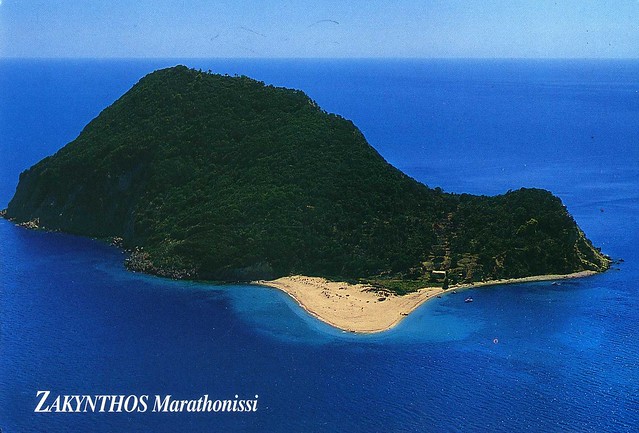
Zakynthos is the third largest of the Ionian Islands. It covers an area of 410 km2 and its coastline is roughly 123 km in length. The island is named after Zakynthos, the son of a legendary Arcadian chief Dardanus. The name, like all similar names ending in -nthos, is pre-Mycenaean or Pelasgian in origin. Zakynthos has a thriving tourism industry.
On this card you can see Marathonissi, which, unless I'm very much mistaken, is an islet in the Zakynthos Marine Park, chich encompasses the marine area of the Bay of Laganas, on the southern shores of the island of Zakynthos, and hosts one of the most important sea turtle nesting beaches in the Mediterranean.

I couldn't find any info about the stamp.

Zakynthos is the third largest of the Ionian Islands. It covers an area of 410 km2 and its coastline is roughly 123 km in length. The island is named after Zakynthos, the son of a legendary Arcadian chief Dardanus. The name, like all similar names ending in -nthos, is pre-Mycenaean or Pelasgian in origin. Zakynthos has a thriving tourism industry.
On this card you can see Marathonissi, which, unless I'm very much mistaken, is an islet in the Zakynthos Marine Park, chich encompasses the marine area of the Bay of Laganas, on the southern shores of the island of Zakynthos, and hosts one of the most important sea turtle nesting beaches in the Mediterranean.

I couldn't find any info about the stamp.
The Chesme Church, St Petersburg, Russia
There seems to be lots of absolutely stunning architecture in Russia, and many churches and cathedrals particularly are wonderfully colourful. This one is no exception, in fact this might just be my favourite of the ones I've seen so far - it looks like a candy! :)
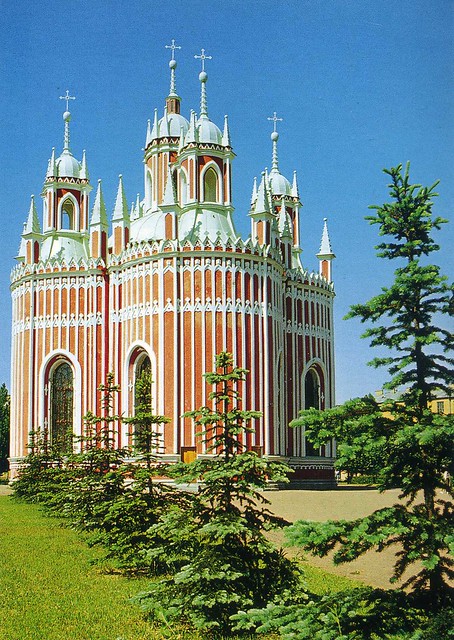
This fairytale gothic church is one of St. Petersburg's most unusual and most delightful, although it is a little off the beaten track for most tourists. Located in the far south of the city, it was built under Catherine the Great as the house church for the Chesme Palace, a resting post between St. Petersburg and the Summer Palace in Tsarskoe Selo. It has since been subsumed in a mostly Stalinist residential region, and is now well within the city limits.
One of two fascinating gothic churches designed by the German-Russian court architect Yury Felton, the Chesme Church was consecrated in 1780, on the tenth anniversary of Russia's naval victory over the Turkish fleet at Chesme Bay, which occurred on the birthday of John the Baptist, hence the church's name. A wedding-cake structure with striped crenellated walls and five gothic turrets in place of traditional onion domes, this truly unique church has survived almost fully intact to this day, despite the fact that it was turned, along with the Chesme Palace, into part of a forced labour camp by the Soviet government - the cross on the central turret was replaced with a hammer, tongs and anvil to symbolize the toil of the proletariat. Just before the Second World War, the complex was given over to the Institute of Aviation Technology, which still occupies the palace to this day.
Used as a burial site for war heroes almost since its consecration, the area around the church became a graveyard for soldiers who died during the Siege of Leningrad. In the 1970s, the church became a Museum of the Battle of Chesme, and was eventually returned to the Orthodox Church in 1990. It is now an extremely popular church, with regular services and numerous visitors who come to pay their respects to the war dead.

The stamp on the right is from the Europa series, this year's theme being Children's Books and this is the Russian contribution to the series. The stamp next to that is from the Russian "Regions" serie, unfortunately I have no idea which region this represents as I can't read Russian. :( The stamp under it is from 2009, a definitive from a set of 12 showing Russian Kremlins. This one here is the Kazan Kremlin. The small stamp on the left is a definitive from 1998 from a set of 11, this one related to agriculture.

This fairytale gothic church is one of St. Petersburg's most unusual and most delightful, although it is a little off the beaten track for most tourists. Located in the far south of the city, it was built under Catherine the Great as the house church for the Chesme Palace, a resting post between St. Petersburg and the Summer Palace in Tsarskoe Selo. It has since been subsumed in a mostly Stalinist residential region, and is now well within the city limits.
One of two fascinating gothic churches designed by the German-Russian court architect Yury Felton, the Chesme Church was consecrated in 1780, on the tenth anniversary of Russia's naval victory over the Turkish fleet at Chesme Bay, which occurred on the birthday of John the Baptist, hence the church's name. A wedding-cake structure with striped crenellated walls and five gothic turrets in place of traditional onion domes, this truly unique church has survived almost fully intact to this day, despite the fact that it was turned, along with the Chesme Palace, into part of a forced labour camp by the Soviet government - the cross on the central turret was replaced with a hammer, tongs and anvil to symbolize the toil of the proletariat. Just before the Second World War, the complex was given over to the Institute of Aviation Technology, which still occupies the palace to this day.
Used as a burial site for war heroes almost since its consecration, the area around the church became a graveyard for soldiers who died during the Siege of Leningrad. In the 1970s, the church became a Museum of the Battle of Chesme, and was eventually returned to the Orthodox Church in 1990. It is now an extremely popular church, with regular services and numerous visitors who come to pay their respects to the war dead.

The stamp on the right is from the Europa series, this year's theme being Children's Books and this is the Russian contribution to the series. The stamp next to that is from the Russian "Regions" serie, unfortunately I have no idea which region this represents as I can't read Russian. :( The stamp under it is from 2009, a definitive from a set of 12 showing Russian Kremlins. This one here is the Kazan Kremlin. The small stamp on the left is a definitive from 1998 from a set of 11, this one related to agriculture.
Waren/Müritz, Germany
If Ireland has become a more common country to me postcard-wise, then the opposite could be said of Germany. I don't know what is going on, but I seem to be getting less and less postcards from Germany, particularly via the official postcrossing site. I've been wondering about that for a while now but haven't come across any explanation so far.

I did receive two beautiful postcards from Germany today, though. The main point of them is actually the stamps used as they're from a stamp swap (I'll send the sender the UK Children's book stamps when they are issued in October), but the cards are very nice as well.
Unless I'm very much mistaken, this picture is from the Müritz National Park, situated roughly in the middle between Berlin and Rostock, in the south of the German state of Mecklenburg-Vorpommern. It extends over large portions of the Müritz lakeland in the two districts of Müritz and Mecklenburg-Strelitz. Müritz National Park was founded in 1990. The total area is 318 km².

Anyway, back to the stamps as they were the point of this card. The one in the top right corner is Germany's contribution to this year's Europa series with the theme "children's books". The other two stamps were also issued this year, they were designed by the singer Udo Lindenberg and are themed on his songs "Andrea Doria" and "Sonderzug nach Pankow".

I did receive two beautiful postcards from Germany today, though. The main point of them is actually the stamps used as they're from a stamp swap (I'll send the sender the UK Children's book stamps when they are issued in October), but the cards are very nice as well.
Unless I'm very much mistaken, this picture is from the Müritz National Park, situated roughly in the middle between Berlin and Rostock, in the south of the German state of Mecklenburg-Vorpommern. It extends over large portions of the Müritz lakeland in the two districts of Müritz and Mecklenburg-Strelitz. Müritz National Park was founded in 1990. The total area is 318 km².

Anyway, back to the stamps as they were the point of this card. The one in the top right corner is Germany's contribution to this year's Europa series with the theme "children's books". The other two stamps were also issued this year, they were designed by the singer Udo Lindenberg and are themed on his songs "Andrea Doria" and "Sonderzug nach Pankow".
Kinsale, Ireland
In the past I very rarely used to get any postcards from Ireland so I always saw it as a "rare" country, which is a bit strange as it's UK's neighbour... Well, now there are some lovely Irish members on the postcrossing forum, and thanks to them my collection of Irish postcards has grown. It's such a beautiful country, too, I always love receiving postcards from there.
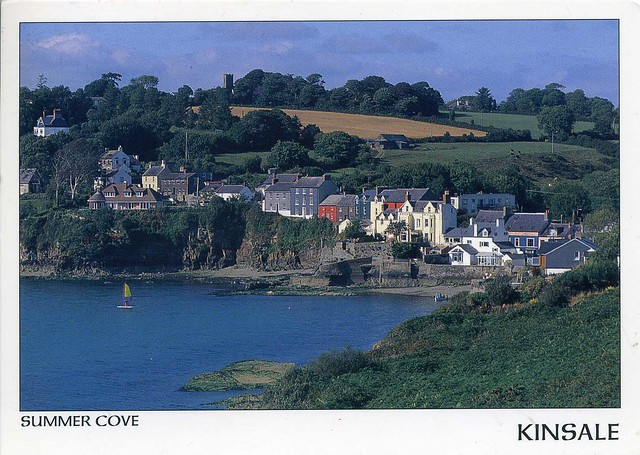
This card came from a RR on the forum. It shows Summer Cove in Kinsale, a town in County Cork, southern Ireland. Located some 25 km south of Cork City on the coast near the Old Head of Kinsale, it sits at the mouth of the River Bandon and has a population of 2,257 which increases substantially during the summer months when the tourist season is at its peak and when the boating fraternity arrive in large numbers.
Kinsale is a popular holiday resort for Irish and foreign tourists which is known for its many gourmet restaurants and leisure activities - including yachting, sea angling, and golf. The town also has several art galleries and a noted school of English. The town is compact with a quaint air of antiquity in the narrow intersecting streets. There is a large yachting marina close to the town centre which attracts sailing enthusiasts. A number of hotels cater for the tourists. The town is noted for its eating establishments, and holds a "Gourmet Festival" annually. The celebrity chef Keith Floyd was previously a resident of Kinsale.

The stamp was issued only a few days ago, at the end of July! It's from a set of four stamps featuring Ireland’s birds of prey (raptors) as part of the Fauna and Flora series. This one here is the Peregrine Falcon.

This card came from a RR on the forum. It shows Summer Cove in Kinsale, a town in County Cork, southern Ireland. Located some 25 km south of Cork City on the coast near the Old Head of Kinsale, it sits at the mouth of the River Bandon and has a population of 2,257 which increases substantially during the summer months when the tourist season is at its peak and when the boating fraternity arrive in large numbers.
Kinsale is a popular holiday resort for Irish and foreign tourists which is known for its many gourmet restaurants and leisure activities - including yachting, sea angling, and golf. The town also has several art galleries and a noted school of English. The town is compact with a quaint air of antiquity in the narrow intersecting streets. There is a large yachting marina close to the town centre which attracts sailing enthusiasts. A number of hotels cater for the tourists. The town is noted for its eating establishments, and holds a "Gourmet Festival" annually. The celebrity chef Keith Floyd was previously a resident of Kinsale.

The stamp was issued only a few days ago, at the end of July! It's from a set of four stamps featuring Ireland’s birds of prey (raptors) as part of the Fauna and Flora series. This one here is the Peregrine Falcon.
Sunday 1 August 2010
Rottnest Island, Western Australia
This postcard has been on my "to be posted" list for well over a month now but somehow it has always been left behind. I *really* like this card so it's about time I showed it here. It's one of the gorgeous postcards I received from a swap with Heather in Australia.

Rottnest Island is located 18 km off the coast of Western Australia, near Fremantle, and a 30 minute ferry ride out from Perth, in the Indian Ocean. It is called Wadjemup by the Noongar people, meaning "place across the water". The island is 11 kilometres long, and 4.5 kilometres at its widest point with a total land area of 19 km². It is classified as an A Class Reserve and is managed by the Rottnest Island Authority. No private ownership of land is allowed.
Rottnest Island was inhabited by Aboriginal people from approximately 30,000 years ago, until rising sea levels separated the island from the mainland of Western Australia approximately 7,000 years ago. The island features in Noongar Aboriginal mythology as Wadjemup. Aboriginal artefacts on the island have been dated from 6,500 to more than 30,000 years ago.
There were no people on the island when European exploration began in the 17th century, and the Aboriginal people did not have boats that could make the crossing, so the island had probably been uninhabited for several thousand years.
The island became largely devoted to recreational use from the 1900s, aside from a brief period of exclusive military use during World War II. It is now visited by nearly 500,000 visitors annually. Rottnest Island has very few permanent residents with most island workers commuting from the mainland.
Bathurst Lighthouse is one of two lighthouses on Rottnest Island, the other being Wadjemup Lighthouse. It is located on Bathurst Point, in the north east of the island, and was activated in 1900. The lighthouse was erected in response to a series of shipping disasters in the area, which included the loss of the City of York in 1899.
Heather tells me that the island was named because the early explorers thought the quokka (related to kangaroos) were 'rats the size of cats'. Thus Rott = rat: ratnest island/Rottnest Island.

The stamps are great again. These are from a set of 6 stamps issued in 2009 with the title "Let's get active!". They are aimed at getting children interested in stamps but also promote kids' sports and incorporate an educational aspect.

Rottnest Island is located 18 km off the coast of Western Australia, near Fremantle, and a 30 minute ferry ride out from Perth, in the Indian Ocean. It is called Wadjemup by the Noongar people, meaning "place across the water". The island is 11 kilometres long, and 4.5 kilometres at its widest point with a total land area of 19 km². It is classified as an A Class Reserve and is managed by the Rottnest Island Authority. No private ownership of land is allowed.
Rottnest Island was inhabited by Aboriginal people from approximately 30,000 years ago, until rising sea levels separated the island from the mainland of Western Australia approximately 7,000 years ago. The island features in Noongar Aboriginal mythology as Wadjemup. Aboriginal artefacts on the island have been dated from 6,500 to more than 30,000 years ago.
There were no people on the island when European exploration began in the 17th century, and the Aboriginal people did not have boats that could make the crossing, so the island had probably been uninhabited for several thousand years.
The island became largely devoted to recreational use from the 1900s, aside from a brief period of exclusive military use during World War II. It is now visited by nearly 500,000 visitors annually. Rottnest Island has very few permanent residents with most island workers commuting from the mainland.
Bathurst Lighthouse is one of two lighthouses on Rottnest Island, the other being Wadjemup Lighthouse. It is located on Bathurst Point, in the north east of the island, and was activated in 1900. The lighthouse was erected in response to a series of shipping disasters in the area, which included the loss of the City of York in 1899.
Heather tells me that the island was named because the early explorers thought the quokka (related to kangaroos) were 'rats the size of cats'. Thus Rott = rat: ratnest island/Rottnest Island.

The stamps are great again. These are from a set of 6 stamps issued in 2009 with the title "Let's get active!". They are aimed at getting children interested in stamps but also promote kids' sports and incorporate an educational aspect.
Panama
Something completely different now... Moving on to the Americas, this one is my second ever (written and stamped) postcard from Panama. Big thank you to Yanireth who sent me this card!

In the picture you can see KUNA indians wearing their traditional clothes. Kuna is the name of an indigenous people of Panama and Colombia. In the Kuna language, the name is Dule or Tule, meaning "people," and the name of the language in Kuna is Dulegaya, meaning "Kuna language" (literally "people-mouth.")
The Kuna live in three politically autonomous comarcas or reservations in Panama, and in a few small villages in Colombia. There are also communities of Kuna people in Panama City, Colón, and other cities. The greatest number of Kuna people live on small islands in the comarca of Kuna Yala. The other two Kuna comarcas in Panama are Kuna de Madugandí and Kuna de Wargandí.
The Kuna are famous for their molas, a colorful textile art form made with the techniques of applique and reverse appliqué. Mola panels are used to make the blouses of the Kuna women's national dress, which is worn daily by many Kuna women. Mola means "clothing" in the Kuna language. The Kuna word for a mola blouse is Tulemola, (or "dulemola") "Kuna people's clothing."

The stamps are great, too. The bigger one is from a set of 17 stamps issued in 2003 under the theme "Centenary of the Republic of Panama 1903 to 2003". The other two stamps are from a set of 6 stamps issued in 2007 depicting tourism.

In the picture you can see KUNA indians wearing their traditional clothes. Kuna is the name of an indigenous people of Panama and Colombia. In the Kuna language, the name is Dule or Tule, meaning "people," and the name of the language in Kuna is Dulegaya, meaning "Kuna language" (literally "people-mouth.")
The Kuna live in three politically autonomous comarcas or reservations in Panama, and in a few small villages in Colombia. There are also communities of Kuna people in Panama City, Colón, and other cities. The greatest number of Kuna people live on small islands in the comarca of Kuna Yala. The other two Kuna comarcas in Panama are Kuna de Madugandí and Kuna de Wargandí.
The Kuna are famous for their molas, a colorful textile art form made with the techniques of applique and reverse appliqué. Mola panels are used to make the blouses of the Kuna women's national dress, which is worn daily by many Kuna women. Mola means "clothing" in the Kuna language. The Kuna word for a mola blouse is Tulemola, (or "dulemola") "Kuna people's clothing."

The stamps are great, too. The bigger one is from a set of 17 stamps issued in 2003 under the theme "Centenary of the Republic of Panama 1903 to 2003". The other two stamps are from a set of 6 stamps issued in 2007 depicting tourism.
Geirangerfjorden, Norway
Another cool card I've received recently... This one is from the lovely Iina, she sent this to me from her holiday in Norway. I have such lucky friends - they get to visit such cool places! Don't get me wrong, I'm very excited to get to go to Finland in two weeks but it's hardly exotic (and everyone already has tons of postcards from Finland :P).
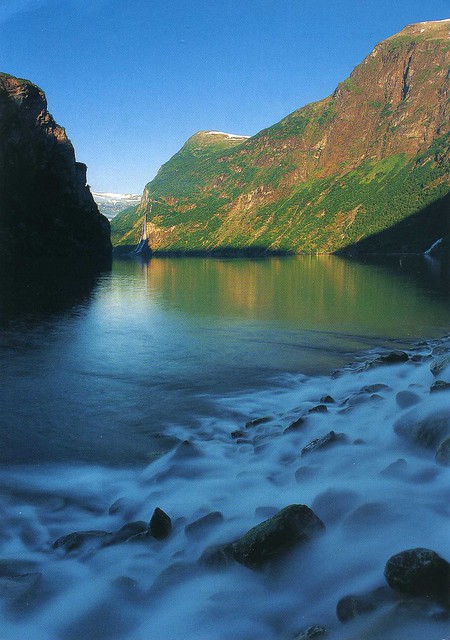
The Geiranger fjord (Geirangerfjorden) is a fjord in the Sunnmøre region, located in the southernmost part of the county Møre og Romsdal in Norway. It is a 15 km long branch of the Storfjord (Great Fjord). At the head in the fjord lies the small village of Geiranger.
The fjord is one of Norway's most visited tourist sites and has been listed as a UNESCO Heritage Site, jointly with Nærøyfjord, since 2005, although this status is now threatened by the disputed plans to build power lines across the fjord.
The Geirangerfjord is under constant threat from the mountain Åkerneset which is about to erode into the fjord. A collapse would produce a tsunami, hitting several nearby towns including Geiranger and Hellesylt in about ten minutes.
Along the fjord's sides there lie a number of now abandoned farms. Some restoration has been made by the 'Storfjordens venner' association. The most commonly visited among these are Skageflå, Knivsflå, and Blomberg. Skageflå may also be reached on foot from Geiranger, while the others require a boat excursion. The fjord is also host to several impressive waterfalls.

The stamp is gorgeous, too. It's from a set of 3 stamps issued in 2008, depicting Wildlife in Norway. Here you can see the Elk.

The Geiranger fjord (Geirangerfjorden) is a fjord in the Sunnmøre region, located in the southernmost part of the county Møre og Romsdal in Norway. It is a 15 km long branch of the Storfjord (Great Fjord). At the head in the fjord lies the small village of Geiranger.
The fjord is one of Norway's most visited tourist sites and has been listed as a UNESCO Heritage Site, jointly with Nærøyfjord, since 2005, although this status is now threatened by the disputed plans to build power lines across the fjord.
The Geirangerfjord is under constant threat from the mountain Åkerneset which is about to erode into the fjord. A collapse would produce a tsunami, hitting several nearby towns including Geiranger and Hellesylt in about ten minutes.
Along the fjord's sides there lie a number of now abandoned farms. Some restoration has been made by the 'Storfjordens venner' association. The most commonly visited among these are Skageflå, Knivsflå, and Blomberg. Skageflå may also be reached on foot from Geiranger, while the others require a boat excursion. The fjord is also host to several impressive waterfalls.

The stamp is gorgeous, too. It's from a set of 3 stamps issued in 2008, depicting Wildlife in Norway. Here you can see the Elk.
Alaska Railroad
Let's stay in arctic regions... Moving on to Alaska, a US state I have a soft spot (probably partly due to watching Northern Exposure as a kid, although I can't remember much of that tv series anymore...). This is a surprise card from Helen in the US, with whom I've swapped cards a couple of times.

This postcard just looks so surreal to me. The colours are amazing and I love the contrast of the pink flowers at the front and the golden-blue mountains at the back, while the colours of the train match the scene perfectly. Apparently these pink flowers are everywhere in Alaska.
From the back of the card:
The Alaska Railroad provides both passenger and freight service from Seward to Anchorage and all the way on to Fairbanks in the interior of the state. One popular destination for many passengers is Denali National Park, seen here in the distance.

..and here are the famous Simpsons stamps again :) They are from a set of 5 stamps, issued in 2009. The smaller stamp is a definitive stamp from the American design series, issued in 2003. This one shows American Clock. I like it how clear the cancellation is, too!

This postcard just looks so surreal to me. The colours are amazing and I love the contrast of the pink flowers at the front and the golden-blue mountains at the back, while the colours of the train match the scene perfectly. Apparently these pink flowers are everywhere in Alaska.
From the back of the card:
The Alaska Railroad provides both passenger and freight service from Seward to Anchorage and all the way on to Fairbanks in the interior of the state. One popular destination for many passengers is Denali National Park, seen here in the distance.

..and here are the famous Simpsons stamps again :) They are from a set of 5 stamps, issued in 2009. The smaller stamp is a definitive stamp from the American design series, issued in 2003. This one shows American Clock. I like it how clear the cancellation is, too!
Greenland
This postcard has got to be one of the biggest surprises I've ever had when checking the mail I've received. I was certain I couldn't see properly, I mean how could I ever receive a written and stamped postcard from GREENLAND?!?

...well, it's most definitely real, and it came directly from Greenland. It's from a postcard pal of mine, Johanna, who was on a two weeks holiday in Greenland with her sister. HOW do you go on holiday in Greenland?!? I had always imagined it would be impossibly difficult to get there; surely it's not the most popular tourist destination?!?
The card shows sheep farming in South Greenland. The houses all look so cute and colourful! Johanna told me that all houses in Greenland seemed to be very colourful and bright and you can't really find two houses that would look alike. She also told me there are lots of mountains and rocks in Greenland, and small flowers grow everywhere. It certainly looks and sounds like a fascinating country - how cool would it be to visit there one day?!

The stamp is more than perfect, too - this year's Europa stamp with the theme "children's books". Thank you so much, Johanna!!

...well, it's most definitely real, and it came directly from Greenland. It's from a postcard pal of mine, Johanna, who was on a two weeks holiday in Greenland with her sister. HOW do you go on holiday in Greenland?!? I had always imagined it would be impossibly difficult to get there; surely it's not the most popular tourist destination?!?
The card shows sheep farming in South Greenland. The houses all look so cute and colourful! Johanna told me that all houses in Greenland seemed to be very colourful and bright and you can't really find two houses that would look alike. She also told me there are lots of mountains and rocks in Greenland, and small flowers grow everywhere. It certainly looks and sounds like a fascinating country - how cool would it be to visit there one day?!

The stamp is more than perfect, too - this year's Europa stamp with the theme "children's books". Thank you so much, Johanna!!
Split, Croatia
Another swap card from Croatia, and such a beautiful card, too!
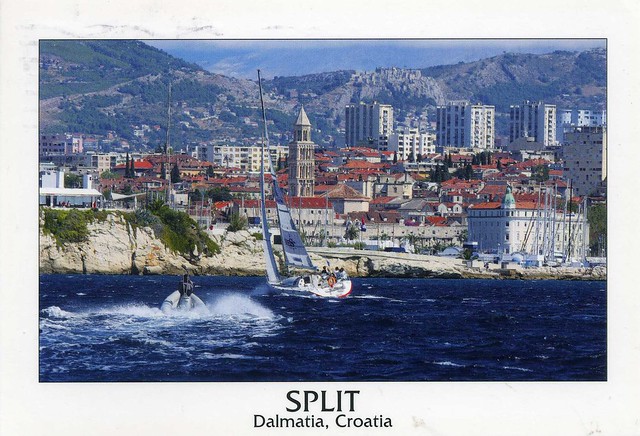
This card shows Split, which is the sender's home town. Split is the largest Dalmatian city, the second-largest urban centre in Croatia, and the seat of Split-Dalmatia County. The city is located on the shores of the Mediterranean, more specifically on the eastern shore of the Adriatic Sea, spreading over a central peninsula and its surroundings, with its metropolitan area including the many surrounding seaside towns as well. An intraregional transport hub, the city is a link to the numerous surrounding Adriatic islands and the Apennine peninsula, as well as a popular tourist destination. On this card you can see the place where a lot of famous people from Split and Dalmatia keep their yachts.
Split is also one of the oldest cities in the area, and is traditionally considered just over 1,700 years old, while archaeological research relating to the ancient Greek colony of Aspálathos (6th century BC) establishes the city as being several hundred years older.

This card shows Split, which is the sender's home town. Split is the largest Dalmatian city, the second-largest urban centre in Croatia, and the seat of Split-Dalmatia County. The city is located on the shores of the Mediterranean, more specifically on the eastern shore of the Adriatic Sea, spreading over a central peninsula and its surroundings, with its metropolitan area including the many surrounding seaside towns as well. An intraregional transport hub, the city is a link to the numerous surrounding Adriatic islands and the Apennine peninsula, as well as a popular tourist destination. On this card you can see the place where a lot of famous people from Split and Dalmatia keep their yachts.
Split is also one of the oldest cities in the area, and is traditionally considered just over 1,700 years old, while archaeological research relating to the ancient Greek colony of Aspálathos (6th century BC) establishes the city as being several hundred years older.
Croatia
I've been doing some private swaps recently, this came from one such swap. It's SUCH a nice map card, too - I love the sea, and the little pictures.

Croatia has a bird like shape, so when you look for it on the map of Europe you just have to remember to look for a bird :) On this card you can also see 6 out of 8 national parks and 6 out of 7 Unesco sites of Croatia. One of my favourite parts of this card is the little wolf, and Dubrovnik looks gorgeous as ever. Croatia seems very much like a hidden gem in Europe - how come it's not so well known (at least not around here)?!

The red stamp on the left was issued in 2008, in a set of 5 stamps portraying Croatian Ethnographic Heritage. This one shows Local Customs from Bistra. The stamp on the right was issued in 2008 under the theme Famous Croats. This stamp commemorates the 125th Anniversary of the birth of Ivan Mestrovic.

Croatia has a bird like shape, so when you look for it on the map of Europe you just have to remember to look for a bird :) On this card you can also see 6 out of 8 national parks and 6 out of 7 Unesco sites of Croatia. One of my favourite parts of this card is the little wolf, and Dubrovnik looks gorgeous as ever. Croatia seems very much like a hidden gem in Europe - how come it's not so well known (at least not around here)?!

The red stamp on the left was issued in 2008, in a set of 5 stamps portraying Croatian Ethnographic Heritage. This one shows Local Customs from Bistra. The stamp on the right was issued in 2008 under the theme Famous Croats. This stamp commemorates the 125th Anniversary of the birth of Ivan Mestrovic.
Subscribe to:
Posts (Atom)


 Maroon
Maroon 









































































































































































